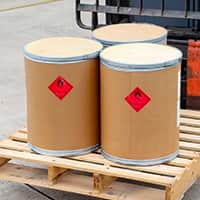What Are the Classes of HAZMAT Materials?
Written by Michael Purser | Edited by Nate Bortz

Hazardous materials, or HAZMAT, can be found in workplaces across many industries. They may be an essential part of your job or the byproduct of a crucial process. No matter where or why you encounter these harmful substances, they represent a significant danger to the unprepared.
It’s important to understand the different classes of HAZMAT materials. This article will help you learn about hazardous materials classifications as well as key regulations and training requirements.
Classifications and Definitions
49 CFR 173.2 defines nine classes of hazardous materials:
- Explosives
- Gases
- Flammable Liquid and Combustible Liquid
- Flammable Solid, Spontaneously Combustible and Dangerous When Wet
- Oxidizer and Organic Peroxide
- Poison (Toxic) and Poison Inhalation Hazard
- Radioactive
- Corrosive
- Miscellaneous
Some of those classes, especially explosives and gases, have several sub-designations. Those may include an explosive class material that is primarily a fire hazard versus a blast hazard. Gases may be poisonous or flammable, which changes the placards that must be attached during use, storage and transit.
DOT Regulations
The U.S. Department of Transportation (DOT) manages the definitions and standards for classified substances. The Pipeline and Hazardous Materials Safety Administration (PHMSA) is part of the DOT. This agency ensures the safe and secure movement of dangerous chemicals and substances.
PHMSA regulations and standards are collectively referred to as Hazardous Materials Regulations (HMR). All HMR can be found in Parts 171-180 of Title 49 of the Code of Federal Regulations.
OSHA and Communication Standards
Under federal guidelines, OSHA developed the Hazard Communication Standard (HCS). This standard requires employers to provide information about chemicals in the workplace and their associated hazards. A simple, graphical system allows workers to identify dangers with a glance.
Thanks to HCS, you can find information on HAZMAT classifications on labels, Safety Data Sheets, vehicles, buildings and every other place where harmful chemicals may be stored. Keeping and communicating data about dangerous goods is key to OSHA’s safety mission.
Learning the Rules Online
All workers should be trained to recognize harmful chemicals and understand potential safety risks. Certain employees will need specialized training depending on their job role and duties.
If you are involved in the transportation of hazardous materials, for example, you are required by 49 CFR 172.704 Subpart H to complete DOT HAZMAT training within 90 days of starting work and take refresher training every three years. This requirement is usually called HM-181.
The amount and type of education you need depends on your exposure risk. OSHA Education Center offers all the major DOT training you need to comply with HM-181 as well as entry-level certificate courses on related topics.
All our courses are available 100% online. Once you enroll in a class, you can start and stop studying as often as you like. We automatically save your progress as you learn how to safely handle, store and transport substances under HMR.
Online education is a fast and convenient way to satisfy education requirements and protect yourself on the job. Start your DOT HAZMAT training online today.
If you have additional questions or would like to know more about our programs, visit our FAQ page.
DOT HAZMAT Transportation: Basic General Awareness Training
All employees who work around hazardous materials must complete at least four hours of instruction. That includes shippers, packagers, labelers and even office workers. If you have limited or indirect access to substances outlined in 49 CFR 173.2, this is the course for you.
This course will teach you to:
- Understand the nine classes of dangerous goods
- Interpret hazard placards
- Identify regulated materials
- Package and document shipments including classified substances
- Fill out and retain necessary documentation
DOT HAZMAT Transportation: All-in-One Training
If you are directly involved in the handling, management, transportation or shipping of hazardous materials, you need this course. You must also satisfy DOT training requirements if you supervise employees who have any of those job functions.
This education program covers regulations at all steps in the process, including:
- Handling
- Preparing
- Packaging
- Shipping
- Transporting
- Loading and unloading
- Responding to emergencies involving regulated substances
- Managing
- And more
Hazardous Chemical Information Training
Even if you don’t work directly with the hazards described above, all workers should receive a basic education in chemical hazards and the HAZMAT classification system. This simple awareness course will teach you how to read placards and navigate the Globally Harmonized System of Classification and Labeling of Chemicals (GHS).
Completing this program will help you understand warning labels common in any workplace and identify potential chemical hazards on your jobsite.
HAZWOPER Training
In addition to the regulations cited above, OSHA requires comprehensive training for any worker who responds to the uncontrolled release of regulated substances. If your job involves cleanup, emergency response or corrective actions, try our online HAZWOPER courses.
We offer a full suite of online HAZWOPER courses, including annual refresher instruction. To learn more, read this informative article.
